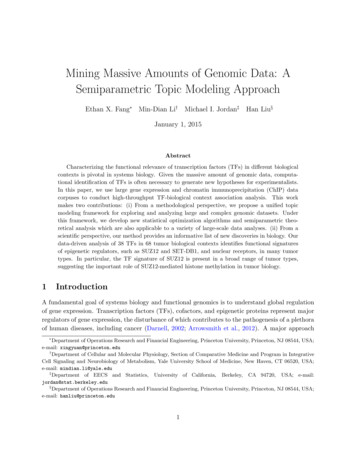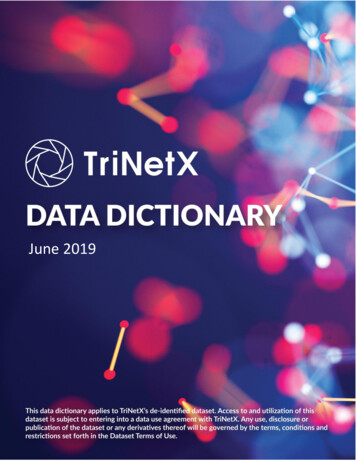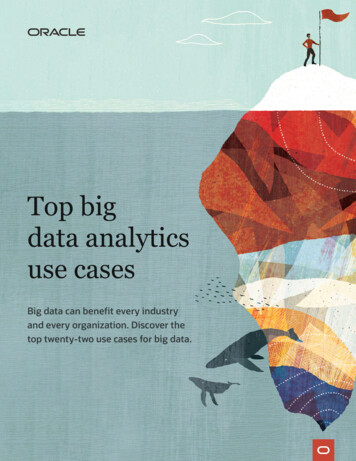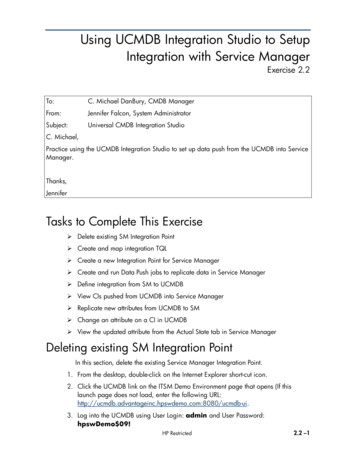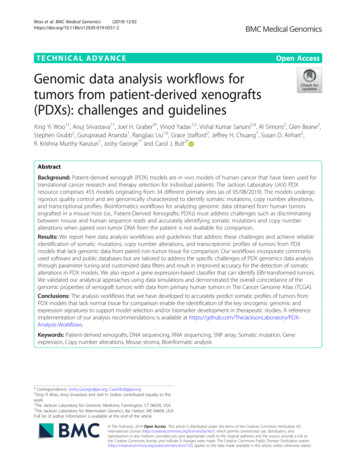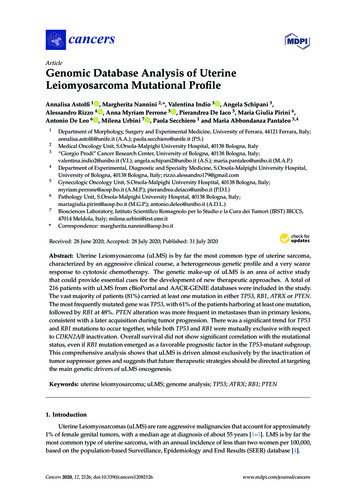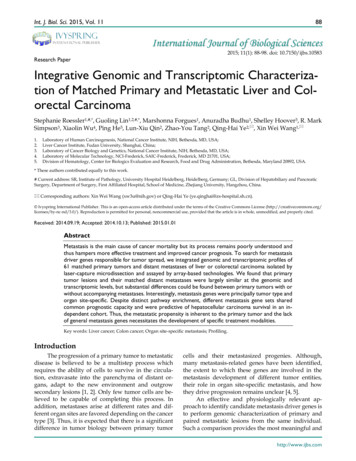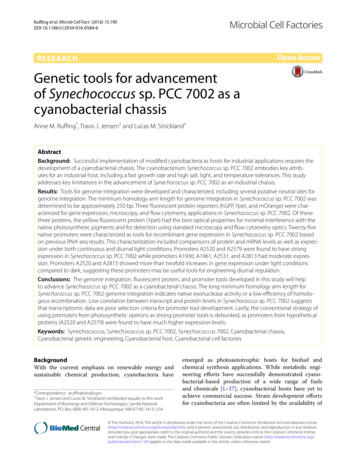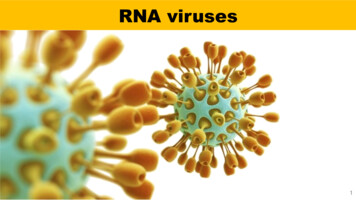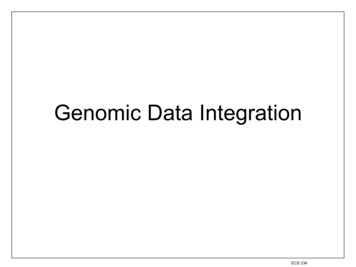
Transcription
Genomic Data IntegrationECS 234
Heterogeneous Data Integration DNA Sequence Microarray Proteomics gi 12004594 gb AF217406.1 Saccharomyces cerevisiae uridine nucleosidase (URH1) gene, complete CCATACCTAAAAAAATC10.50-0.5-10-0.5-11 3 5 7 9 11 13 15 17Important to Integrate!1 2 3 4 5 6 7 8 9 10 gi 13534 emb V00696.1 MISC16 Yeast (S. cerevisiae) mitochondrial gene for 11 3 5 7 9 11 13 15 17Yeast GenesECS 234
ChIP-chip Data(Large-Scale Genomewide Location Data) Detecting physical TF binding to DNA on a large scale Binding confidence P-value for each TF and DNA .120.011BUT: Localizes the binding coarsely, to a 1000-2000 bp region It doesn’t say anything about the nature of the regulation It is noisyECS 234
Using ChIP-chip Data(Lee et al. 2002) Transcriptional Regulatory Networks in S.Cerevisiae (yeast) 106 TFs, 6000 genes of yeast P-value: 0.001 (1/10 % by chance) Connect the TFs to the genes theyregulate above that threshold The result is a regulatory networkECS 234
Network Analysis Detects ComponentReuse (Network Motifs)ECS 234
Gene Modules and The Cell Cycle TF-DNA data combinedwith Expression Datafrom 500 experiments Multi-Input NetworkMotifs Coexpressedgenes MIM-CE(coexpressed andcoregulated genemodules) MIM-CE aligned withknown genes expressedin different parts of thecell-cycle Result: cell cyclemodular regulatorynetworkECS 234
Improved Expression TF-DNAIntegration: Gene Modules (Bar-Joseph et al. 2003) GRAM algorithm:eliminate the strictsignificance threshold(P-value) for TF-DNAbinding byconsideringexpression data Find coexpressedgenes and theirregulators (ie genemodules)ECS 234
Benefits of IntegrationGRAM detectedgene modules aremore likely tocontain upstreamthe appropriatebinding sites (fromTRANSFAC) thenthe modulesdetected by usingTF-DNA data onlyECS 234
Results From IntegrationECS 234
ChIP-chip Promoter Sequence(Liu et al. 2002) TF-DNA binding is very coarsely localized withChIP-chip data To find the actual binding sites use the TF-DNAbinding evidence to narrow down the searchspace for motif finding MDscan: rank the DNA sequences and givemore weight to sequences more enriched for TFbinding Works better than motif finders that do not takeTF-DNA binding into accountECS 234
Sequence ChIP-chip Expression Data (de Bie et al, 2004) Uses 3 independent data sources of yeast:– M, Sequence motifs (obtained by comparative genomics)– R, ChIP-chip binding (from Young’s lab)– A, Microarray expression data experiments A module is:– A set of regulators– A set of genes it regulates– A set of sequence motif where the regulators bind Algorithm: simple threshold based procedure foreach data source, made efficient by observinghierarchical properties of modulesECS 234
ResultsKnown functional gene modules in yeast identifiedECS 234
Protein-Protein Interaction Data (PPI) Yeast-two-HybridtechnologyLarge-scaleAvailable for yeast,drosophilaYeast PPI Network (largest cluster): nodes are proteins, edges PPIs(red, lethal; green, non-lethal; orange, slow growth; yellow, unknown)Jeong et al. Nature 2001ECS 234
Gene Expression PPI Data(Ge et al., 2001)Goals2. To compare the levels ofinteraction between proteinsencoded by co-expressed genesvs. proteins not encoded by coexpressed genes3. Improved modeling of proteinprotein interactionsMethodsCalculate protein interactiondensity, and correspondingsignificance within and betweenco-expressed clusters of genesECS 234
Transcriptome – InteractomeCorrelation MapsECS 234
More Knowledge Yields Better Modelsa) Protein-protein interaction datab) Protein Interaction Gene Expression DataStress response proteinsECS 234
Protein Function Prediction(Marcotte et al., 1999)Combining various strategies to linkfunctionally related proteins. Total: 93750 linksorLink confidence: highest confidence (4130 links) high confidence (19521 links) restECS 234
4. Putting It All Together?Davidson etal., 2002ECS 234
Bibliography Lee et al., Transcriptional regulatory networks in S. Cerevisiae, Science 2002De Bie et al., Discovering transcriptional modules from motif, ChIP-chip and microarray data, PSB2004Liu et al., An algorithm for finding protein-DNA binding sites with applications to chromatinimmunoprecipitation microarray experiments, Nat. Biotech, 2002Bar-Joseph et al., Computational discovery of gene modules and regulatory networks, Nat.Biotech. 2003Marcotte et al., A Combined Algorithm for Genome-wide Prediction of Protein Function, Nature, v.402, 1999, 83-86.Ge et al., Correlation Between Transcriptome and Interactome Mapping Data fromSaccharomyces Cerevisiae, Nature Genetics, v. 29, 2001, 482-486.OTHER: Chiang et al., Visualizing Associations Between Genome Sequences and Gene Expression DataUsing Genome-Mean Expression Profiles, Bioinformatics, v. 17, 2001, S49-S55. Davidson et al., A Genomic Regulatory Network for Development.Science 295 (5560): 1669-2002 Filkov et al., Analysis Techniques for Microarray Time-Series Data, Journal of ComputationalBiology 9(2): 317-330 (2002). Filkov and Skiena, Integrating Heterogeneous Data Sets via Consensus Clustering, 2003 (inprogress) Hartemnik et al., Combining Location and Expression Data for Principled Discovery of GeneticRegulatory Network Models, Pacific Symposium on Biocomputing 2002. Pavlidis et al., Learning Gene Functional Classification from Multiple Data Types, Journal ofComputational Biology, v. 9, 2002, 401-411.ECS 234
Genomic Data Integration. ECS 234-1-0.5 0 0.5 1 1 3 5 7 9 11 13 15 17-1-0.5 0 0.5 1 1 3 5 7 9 11 13 15 17-1 . Improved modeling of protein-protein interactions Methods Calculate protein interaction density, and corresponding significance within and between co-expressed clusters of genes.
